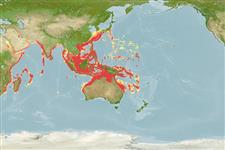Malacostraca |
Decapoda |
Scyllaridae
Environment: milieu / climate zone / пределы глубины / distribution range
экология
; пределы глубины 0 - 1399 m (ссылка 99823), usually 10 - 50 m (ссылка 116221). Tropical; 35°N - 28°S, 32°E - 169°E (ссылка 4)
Indo-West Pacific.
Length at first maturity / Size / Weight / Возраст
половая зрелость: Lm ? range ? - ? cm Max length : 4.0 cm TL самец/пол неопределен; (ссылка 4); 6 cm TL (female)
Carapace with two distinct teeth in the median line before the cervical groove (the gastric and pregastric teeth), the rostral tooth is absent, and replaced by an inconspicious tubercle. The region between the postrostral and branchial carinae shows many tubercles, especially in the posterior half of the carapace. The abdomen has a conspicuously elevated longitudinal median carina on somites 2 to 5, that of smite 2 shows as an inverted V-shaped ridge when looked at dorsally. The carina of somite 3 is somewhat higher than the others. Somite 1 shows a complete transverse groove behind which there are about 16 straight , parallel longitudinal unbranched grooves, which are quite characteristic for the species. The other somites show a somewhat arborescent pattern on the exposed part. The fourth segment of the antenna has, apart from the distinct and sharp oblique median carina, an additional short curved carina formed by a row of tubercles; this additional carina is on the outer half of the segment. The outer margin of the segment has 3 to 5 (mostly 3) distinct teeth (apical tooth not included), the inner margin has 5 to 9 teeth, the basal of which is largest. The anterior margin of the thoracic sternum is very shallowly concave, narrowly incised in the middle and with a small tubercle either side of that incision. Sternites 2 to 4 show a faint median tubercle each. The pereiopods show no hairy fringes om the dactyli. Colour: the body is yellowish or reddish brown, somewhat ireegularly marbled. A darker brown transverse band may be present on the third abdominal somite. The leg show a darker band on some of the segments (Ref. 252).
It has lengths of 2 to 4 cm (males), 2 to 6 cm (females) and 2.5 to 4 cm (ovigerous females), total body length; 0.4 to 1.3 cm (males), 0.7 to 2 cm (females) and 0.5 to 1.5 cm (ovigerous females), carapace length (Ref. 4). It inhabits soft and smooth substrates, consisting of sand and/or mud, sometimes with shells, pumice, foraminiferans or bryozoans (Ref. 4). Nistos are found to bury in sandy substrates during the day. Larvae are closely associated with medusae (Ref. 106412).
Life cycle and mating behavior
половая зрелость | размножение | нерест | Eggs | Fecundity | Larvae
Members of the order Decapoda are mostly gonochoric. Mating behavior: Precopulatory courtship ritual is common (through olfactory and tactile cues); usually indirect sperm transfer.
Основная ссылка
ссылки | координатор | соавторы
Holthuis, L.B. 1991 FAO Species Catalogue. Vol. 13. Marine lobsters of the world. An annotated and illustrated catalogue of species of interest to fisheries known to date. FAO Fish. Synop. 125(13):292p. Rome: FAO. (ссылка 4)
Статус Красного Списка МСОП
(ссылка 130435: Version 2025-1)
Статус СИТЕС (ссылка 108899)
Not Evaluated
CMS (ссылка 116361)
Not Evaluated
Угроза для людей
Использование человеком
рыболовство: интереса не представляет
| FishSource |
инструменты
дополнительная информация
Trophic EcologyFood items (preys)
состав пищи
потребление пищи
хищники
Population dynamicsростMax. ages / sizesLength-weight rel.Length-length rel.Размерный составMass conversionчисленность Life cycleразмножениеполовая зрелостьFecundityнерестEggsРазвитие икрыLarvae PhysiologyOxygen consumption
Human RelatedStamps, coins, misc.
ресурсы в Интернет
Estimates based on models
Preferred temperature
(Ref.
115969): 24.7 - 29.1, mean 28.1 (based on 2184 cells).
Fishing Vulnerability
Low vulnerability (10 of 100).
